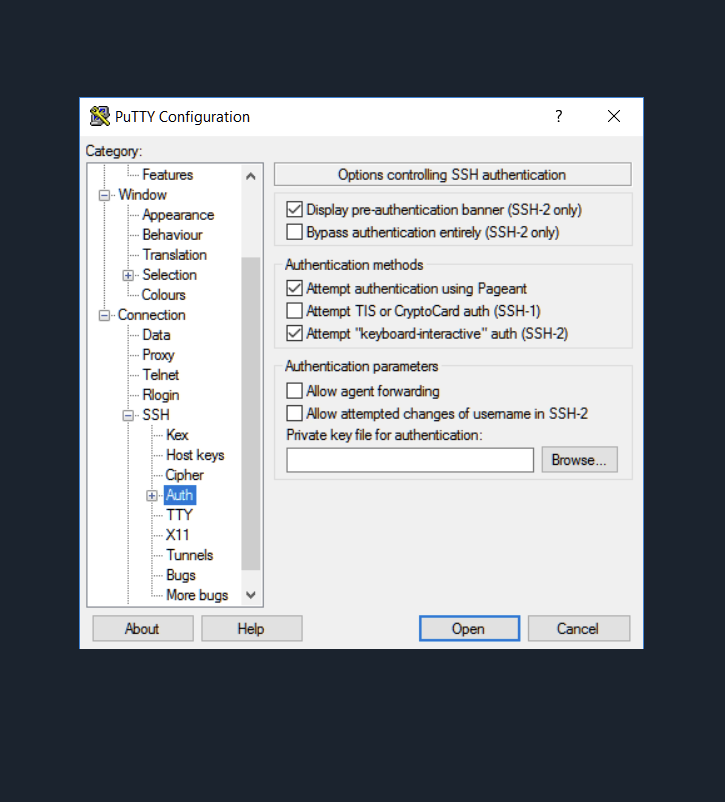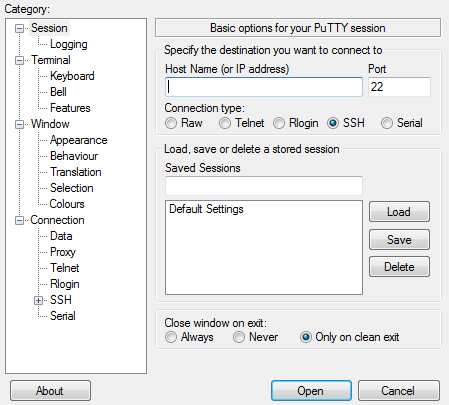
- #Putty ssh command line options how to
- #Putty ssh command line options serial
- #Putty ssh command line options verification
- #Putty ssh command line options password
N don't start a shell/command (SSH-2 only) s remote command is an SSH subsystem (SSH-2 only) no-antispoof omit anti-spoofing prompt after authentication sanitise-stderr, -sanitise-stdout, -no-sanitise-stderr, -no-sanitise-stdoutĭo/don't strip control chars from standard output/error Manually specify a host key (may be repeated) noshare disable use of connection sharing i key private key file for user authenticationĭisconnect if SSH authentication succeeds trivially 1 -2 force use of particular SSH protocol version The following options only apply to SSH connections:
#Putty ssh command line options serial
Specify the serial configuration (serial only) load sessname Load settings from saved sessionįorce use of the bare ssh-connection protocol pgpfp print PGP key fingerprints and exit ("host" can also be a PuTTY saved session name)
#Putty ssh command line options how to
This tells you the version of Plink you're using, and gives you a brief summary of how to use Plink: Once you've got a console window to type into, you can just type plink on its own to bring up a usage message. This section describes the basics of how to use Plink for interactive logins and for automated processes. On Windows 95, 98, and ME, you will need to edit your AUTOEXEC.BAT to include a set command like the one above. To set your PATH more permanently on Windows NT, 2000, and XP, use the Environment tab of the System Control Panel. This will only work for the lifetime of that particular console window. Set PATH=C:\path\to\putty\directory %PATH% To add the directory containing Plink to your PATH environment variable, type into the console window: In order to use Plink, the file plink.exe will need either to be on your PATH or in your current directory. It should be available from the Programs section of your Start Menu. In Windows 95, 98, and ME, this is called an ‘MS-DOS Prompt’, and in Windows NT, 2000, and XP, it is called a ‘Command Prompt’. This means that you cannot just double-click on its icon to run it and instead you have to bring up a console window. Plink is probably not what you want if you want to run an interactive session in a console window. It is mostly used for automated operations, such as making CVS access a repository on a remote server. Plink is a command-line connection tool similar to UNIX ssh. 7.3 Using Plink in batch files and scriptsĬhapter 7: Using the command-line connection tool Plink.7.2.2 Using Plink for automated connections.7.2.1 Using Plink for interactive logins.Chapter 7: Using the command-line connection tool Plink.Hope you like this post on How to use Putty for SSH.Using the command-line connection tool Plink We can use the Putt圜M tool.It is very useful if you are managing multiple server (4) You can change the terminal color settings using color setting in left hand side (3) You can specify the cursor type and font settings in appearance on the left side (2)You can specify the Number of rows,column and scroll back length in the window option on the left hand side You can put the location of logfile as per your convenience (1) You can log the activities being done on the Putty client using the logging option
#Putty ssh command line options password
Enter the password and you will get the $ sign and now you can proceed with your activities Other features of Putty client which can be used Now you will be shown below on the screenĮnter the Username and then it will ask for password. In case of telnet ,it will directly go to next step If you have chosen SSH protocol which is the default and secure one ,then below message will be displayed Put the server name in host name field and choose the appropriate protocol (d) Username and password and login to the system
#Putty ssh command line options verification
(c) For SSH, it will ask for verification of keys (a)Hostname or IP address of the VPS or dedicated server You should have beforehand before you proceed with below steps



Now we are ready to connect to any Linux or Unix server How to use Putty for SSH or Telnet Now we are ready to launch the client How to launch the clientĭouble-click on the putty.exe program or the desktop shortcut to launch the application. (3) If you want to create a shortcut to PuTTY on your desktop:Ī.Open the C:/tech folder in Windows Explorer.ī Right click on the putty.exe file and select Send To > Desktop


 0 kommentar(er)
0 kommentar(er)
